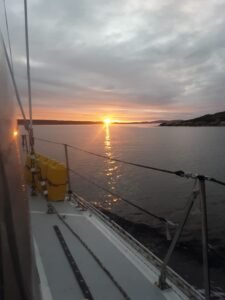
It was supposed to be an easy run from Flowers Cove, Newfoundland, to Chateau Bay, Labrador: gentle southwest wind and a fair tide, even if we did have to get up at two AM to catch it. And the wind was, at least, gentle, even though it was from the opposite quarter than predicted. No matter—Polar Sun can motor against ten knots of headwind with no difficulty. With the ebb to help her along—what the Newfies call the “down tide,” we were making pretty good time up the Strait of Belle Isle. Just a few hours out, though, a re-check of the tide stations showed that we had less tide than we thought. After considerable head-scratching and cross-referencing, we discovered that the tide apps the guys were using on their IPhones were set for different time zones, and had given contradictory information. Not the first time an app has let us down, and probably, alas, not the last.
Well, no matter—we decided to adapt and cut our losses by putting into Red Bay, on the Labrador side, and waiting for the tide to turn again. No sooner had we turned toward it than the engine coughed, sputtered, and was still. Luckily for me, who hates all things engine, we have two mechanics aboard, and it didn’t take long to diagnose and change a clogged fuel filter while I hoisted a sail and headed as near as possible for Red Bay.

Under power again, we made short work of getting in, and were jauntily approaching the public wharf perhaps a bit faster than is necessary when the engine coughed discreetly and died again. While I ineffectually pressed the starter button, Mark, Rudy, and Erik scrambled nimbly to surge Polar Sun to a stop with hasty spring lines.
Sure, the filter was clogged again, but we needed to find out, why today, and never before? Taking the inspection plate off the diesel tank revealed all: someone had painted the inside with a coating that was coming off in flakes and getting sucked into the intake. We picked all the bits out with our fingers and still caught the down tide for Chateau. Forty-five minutes later we were heading back for Red Bay under sail with the silent engine once more in pieces. I had very nearly sailed up to the dock again before the wind failed and we drifted in the entrance until the switch to a different tank was complete.

It took another try or two to believe in the reliability of the engine—the main tank had gotten good and stirred up on a galloping sail to Flowers Cove and all the gunk previously on the bottom was now clogging filters. We motored around Red Bay for a few hours with the secondary tank until persuaded of its quality, then tied up for two nights while a piece of weather came through.

In the interest of time, we decided to skip Chateau Bay and carry on to Mary’s Harbor, even though a 20-knot headwind was predicted. How bad could it be really, so close to land that seas can’t develop? We found out just how bad indeed when Polar Sun was reduced to hobbyhorsing along at a knot and a half in the brutal katabatics that pelted savagely from the rounded hills to punish our insolence. At last we made some sail and tacked out to sea and back, going twice the distance three times as fast, and made it into the shelter of some iceberg-fraught islands through which we hobbled our cold and painful way to Mary’s Harbor. At least the engine didn’t die.
The Labrador Sea, when we ventured back out a day or so later, was still as a pond, and mostly remained so as we crossed toward Greenland. Aside from the occasional iceberg and fog bank, it was a most pleasant three days divided between the motor and the spinnaker.

It got rowdy, though, forty-eight hours from our arrival: double-reefed main and reefed stay’sl rowdy, with wave trains from two directions to disturb our repose. Once we got the Hydrovane self-steering gear sorted, though, which took a while to fine-tune, our only concern was to look out for ice while Polar Sun bowled along at seven and eight knots. It was a grand sail, despite some seasickness among the crew and loose items banging around. Polar Sun showed herself capable of standing up to heavy weather and scooting along regardless, and the Hydrovane of keeping her on course.

It was gusting upwards of forty as we came into the southern inshore channel to Nuuk, and we were glad, both to fetch in the mainsail, and that we hadn’t needed to sooner, since a sun-cooked sheave had split and the mainsheet was immobilized between the fragments. It was near midnight, but the sky was still light, and through driving rain and fog the high hills glinted with patches of snow. Greenland! And what a way to arrive: wet, windblown, and half frozen. Weary but triumphant, we rafted up to a convenient tug in the harbor and turned in. Tomorrow would begin another phase of the voyage—there were things to repair, things to buy, papers to sign, places to explore. Bring it on, I thought. Bring it on, but just let me get a few hours of sleep first.

